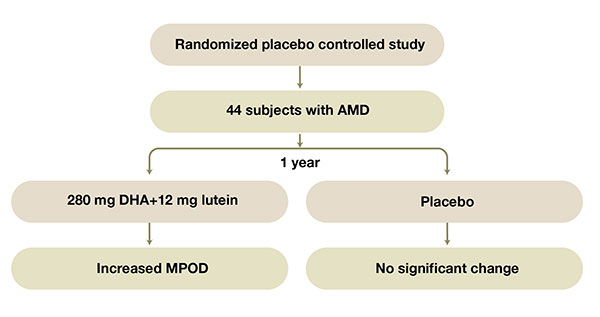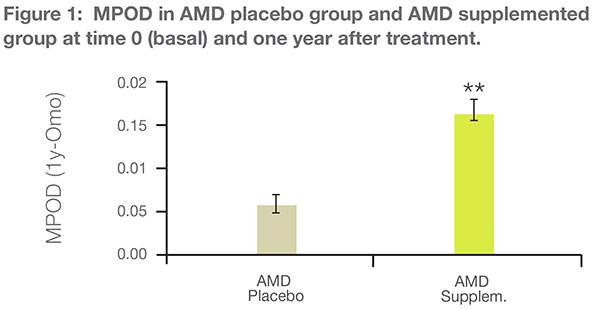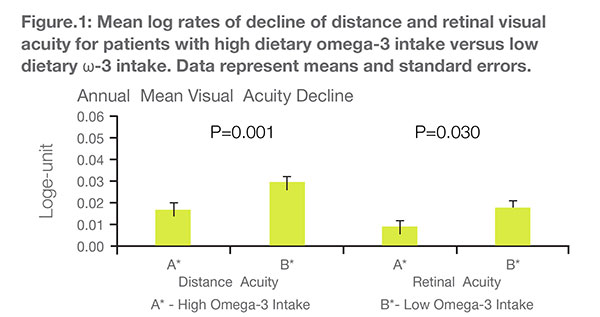It is found that the DHA and lutein supplementation is effective in increasing the macular pigment ocular density (MPOD) and may aid in prevention of age related macular degeneration
This study was performed to assess the efficacy of DHA and lutein combination in preventing AMD.


It was found that DHA plus lutein supplementation is effective in increasing the MPOD and may help in prevention of age related macular degeneration.
Layana GA, Recalde S, Alaman AS, et al. Effects of Lutein and Docosahexaenoic acid supplementation on macular pigment optical density in a randomized controlled trial. Nutrients. 2013; 5:543-551.
A study was conducted to assess whether a diet high in long chain omega-3 fatty acids can slow the rate of loss of visual acuity among patients with retinitis pigmentosa receiving vitamin A palmitate.

357 adult patients who were all receiving vitamin A 15,000 IU/day
Vitamin A 15,000 IU/day for 4-6 years and intake of long chain Omega-3 fatty acids (primarily DHA).
4-6 years

The mean annual rates of decline in distance and retinal visual acuities in adults with retinitis pigmentosa taking vitamin A are slower among those consuming a diet rich in omega-3 fatty acids (primarily DHA).
Berson EL, Rosner B, Sandberg MA, et al. ω-3 intake and visual acuity in patients with retinitis pigmentosa receiving vitamin A. Arch Ophthalmol. 2012; 130(6):707-11
Many studies have demonstrated that DHA is essential for development of nervous system and eyes. There is evidence to suggest that DHA deficiencies increase with normal aging. This study was conducted to assess the efficacy of DHA supplement on visual acuity and cognitive decline in elderly population.
A triple-blind placebo-controlled randomized repeated-measures trial.
74 healthy patients aged between 45-77 years.
1000 mg of tuna oil comprising 252 mg DHA, 60mg EPA and 10 mg vitamin E or placebo.
3 months
The effect of 90 day supplementation with DHA on visual sharpness in healthy elderly population was found to be positive
It was found that DHA supplementation of elderly population is associated with improved visual sharpness.
Stough C, Downey L, Silber B, et al. The effects of 90-day supplementation with the omega-3 essential fatty acid docosahexaenoic acid (DHA) on cognitive function and visual acuity in a healthy aging population. Neurobiol Aging.2012;33(4):824.e1-3.
This study was conducted to examine whether intake of omega-3 fatty acid has any affect on the incidence of age-related macular degeneration (AMD) in women.
38,022 women completed the food-frequency questionnaire and were not having AMD.
Incident AMD responsible for a reduction in best corrected visual acuity to 20/30 or worse based on self-report confirmed by medical record review.
10 years
Data from large cohort of women with no prior AMD indicate that regular intake of DHA significantly reduced the risk of incident AMD
Regular consumption of DHA and EPA significantly reduced the risk of incident AMD. This data appear to be the strongest evidence to support a role for omega-3 long chain fatty acids in the primary prevention of AMD, and also a reduction in the number of persons who ultimately suffer from advanced AMD.
Christen WG, Schaumberg DA, Glynn RJ, et al. Dietary Ω-3 fatty acid and fish intake and incident age-related macular degeneration in women. Arch Ophthalmol. 2011; 129(7):921-9
Disturbances in the cellular production of nitric oxide (NO) and superoxide (O2) can have detrimental effects on retinal vascular integrity and angiogenic signaling. This study was done to assess the affect of ω-3 polyunsaturated fatty acids (PUFAs) on angiogenic signaling and NO/superoxide production in retinal microvascular endothelial cells (RMECs).

DHA improves NO bioavailability, decreases superoxide production, and blunts VEGF-mediated angiogenic signaling. These findings suggest a role for omega-3 PUFAs, particularly DHA, in maintaining vascular integrity while reducing pathologic retinal neovascularization.

Matesanz N, Park G, McAllister H, et al. Docosahexaenoic acid improves the nitroso-redox balance and reduces VEGF-mediated angiogenic signaling in microvascular endothelial cells. Invest Ophthalmol Vis Sci. 2010; 51(12):6815-6825.